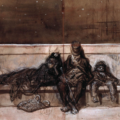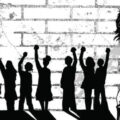For Nietzsche, life’s ultimate question was: ‘Does it dance?’

Friedrich Nietzsche’s body of work is notoriously difficult to navigate. He wrote in multiple styles, including essays, aphorisms, poems, and fiction. He introduced idiosyncratic concepts such as the free spirit, the Übermensch, eternal recurrence, ressentiment, the ascetic ideal, the revaluation of values, and the affirmation of life. He shifted allegiances: writing books, for example, in support of the composer Richard Wagner and the philosopher Arthur Schopenhauer, but later delivering blistering critiques of both. Not surprisingly, scholars range widely in their interpretations of Nietzsche: was he a poet or a philosopher? A nihilist, moral relativist, or Nazi sympathiser? A critic or a system builder? Anti-Christian or Christian? Answers frequently depend on which portions of Nietzsche’s work a reader deems most important.
In the face of this complexity, Nietzsche offers an interpretive key: his references to dance (Tanz). Taken together, these references light a path that begins in Nietzsche’s first book, The Birth of Tragedy (1872), and wends through every major work into his final book, the posthumous Ecce Homo (1908). These references not only link his ideas and styles, they also shed light on Nietzsche’s enduring motivation: to teach readers how to affirm life here and now on Earth as human bodily selves. Nietzsche’s dance references call attention to the sensory education that he insists is necessary for creating values that “remain faithful to the Earth.”
When Nietzsche wrote his first book, he was unaware of the significance that dance would have for his philosophy, in part because he was deeply enamored with Wagner. The musician had begun composing a cycle of four operas—his now-famous Ring—intending to revive the tradition of Ancient Greek tragedies. In so doing, Wagner hoped to realize the power of music that Schopenhauer described: to save humans from the cravings and suffering of Will.
During visits paid by Nietzsche, Wagner and his wife Cosima encouraged the younger man to write a scholarly book to justify these claims. Yet, as Nietzsche later admits, in his rush to laud Wagner (and Schopenhauer), he shortchanged one of his own insights—namely, that, in the tragedies of Ancient Greece, the dancing of the chorus was essential for ensuring that stories of madness, suffering and death nonetheless produce in spectators a rousing affirmation of life.
In The Birth of Tragedy, Nietzsche analyses this paradoxical experience. He explains that the dancing and singing of the chorus move spectators to identify viscerally with what the chorus represents: elemental rhythms of an endlessly creative Nature. As they are moved by these rhythms, spectators feel joy. They know their bodily selves as members of an endlessly generative whole. And from this sensory vantage point, they are not devastated by the tragic death of their hero, god or ideal; instead, they perceive this death as a mere moment in an ongoing flow of appearances. Nietzsche calls the effect a “magic transformation”: spectators’ sensations of suffering and terror yield to feelings of ‘metaphysical comfort’ and the notion that “life is at the bottom of things, despite all the changes of appearances, indestructibly powerful and pleasurable.”
Later, in Human, All Too Human (1878), Nietzsche elaborates that all human symbolism—even music—is rooted in the “imitation of gesture” at work in ancient tragedy. He writes that the human impulse to move with others “is older than language, and goes on involuntarily … [even] when the language of gesture is universally suppressed,” as he observed among Christians of his day. When humans don’t learn how to move their bodily selves, Nietzsche insists, their senses grow dull and they lose the capacity to discern what is good for them. He asks: where are the “Books that teach us to dance”? Here, dance assumes a role it will play throughout Nietzsche’s writing as a litmus test for any value, idea, practice or person. Does it dance? Does it catalyze a joyful affirmation of life?
On the heels of Human, Nietzsche’s poor health forced him to retire from teaching, and he began to conceive plans for writing his own tragedy—a book designed to awaken in his readers a sensory vantage point from which they might experience the death of a god—in this case, the Christian God—as good for them, and a reason to love life. A book that would teach us to dance.
Nietzsche began writing his tragedy only after breaking off relations with his friends, the psychologist Paul Rée and Lou Andreas-Salomé, the woman they both loved. Nietzsche believed that he had found in Andreas-Salomé the one person who understood his quest for a radical affirmation of life. He made plans with her and Rée to live together in an intellectual society that she called their “Unholy Trinity.” However, due primarily to suspicions planted by Nietzsche’s sister Elisabeth, the trio’s plans did not materialise. A despondent Nietzsche wrote to his dear friend Franz Overbeck: “Unless I can discover the alchemical trick of turning this—muck into gold, I am lost.”
Nietzsche’s own ‘magic transformation’ appeared a month later: Part One of Thus Spoke Zarathustra (1883). Three more parts soon followed. In this story, Zarathustra is a man who has lived alone on a mountaintop for 10 years, and comes down to teach people how to love themselves and their humanity. All four parts are saturated with references to dance, dancers and dancing. Zarathustra is a dancer, and dance is what he admonishes others to do. As Zarathustra exhorts: “You higher men, the worst about you is that you have not learned to dance as one must dance—dancing away over yourselves! What does it matter that you are failures? How much is still possible!” And when Zarathustra states: “I would only believe in a god that knows how to dance,” he confirms that even our highest ideals must encourage us to affirm bodily life.
After Zarathustra, Nietzsche continued to evoke dance as a touchstone for life-affirming values. In his critique of western European Christian morality, On the Genealogy of Morals (1887), dance appears as an activity practiced by the strong to preserve their ability to digest their experiences; those who dance are not burdened by ressentiment, or need for revenge. They have the sensory discernment needed to resist pernicious applications of the ascetic ideal. In Twilight of the Idols (1889) and The Antichrist (1895), dance appears as a discipline for training sensory awareness and cultivating skills of perception and responsibility, so that one is able to participate responsibly in the creation of values, conscious of what one’s movements are making.
Nietzsche’s ubiquitous references to dance are ever-present reminders that the work of overcoming oneself—of freeing oneself enough from anger, bitterness and despair to say “Yes!” to life—is not just an intellectual or scientific task. An ability to affirm life demands bodily practices that discipline our minds to elemental rhythms, to the creativity of our senses, and to the “great reason,” our body, “that does not say ‘I’ but does ‘I’.” Only when we engage in such practices will we have the sensory awareness we need in order to discern whether the values we create and the movements we make express love for ourselves and the Earth.
This article was originally published at Aeon and has been republished under Creative Commons.
About Kimerer LaMothe
Kimerer LaMothe is a philosopher, dancer and scholar of religion. She is the author of six books, including Nietzsche’s Dancers: Isadora Duncan, Martha Graham, and the Revaluation of Christian Values (2006) and Why We Dance: A Philosophy of Bodily Becoming (2015). She lives in upstate New York.





